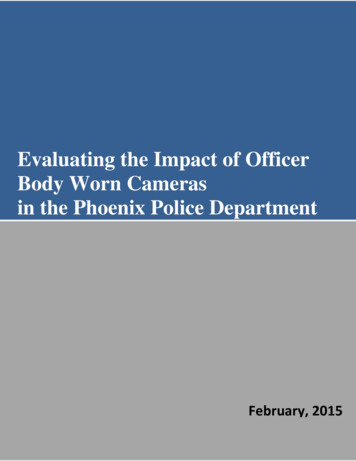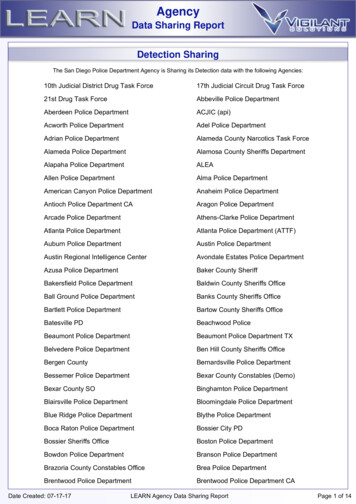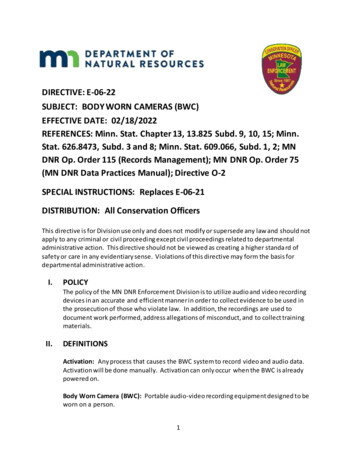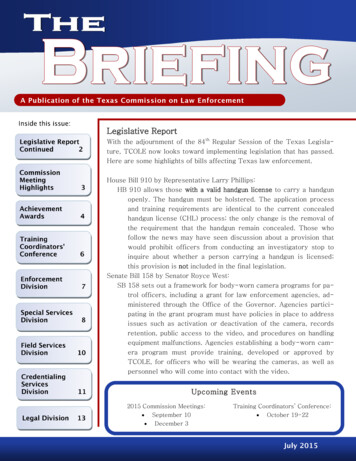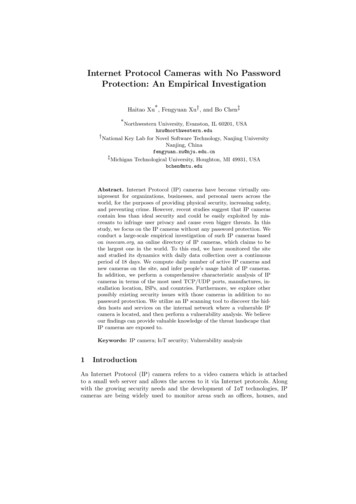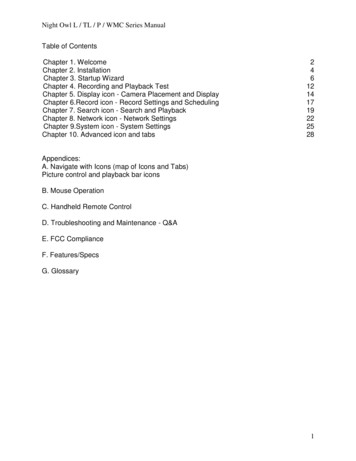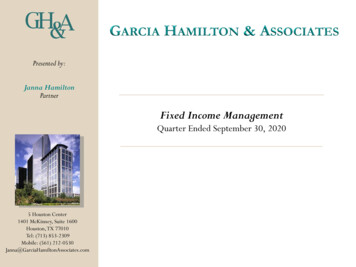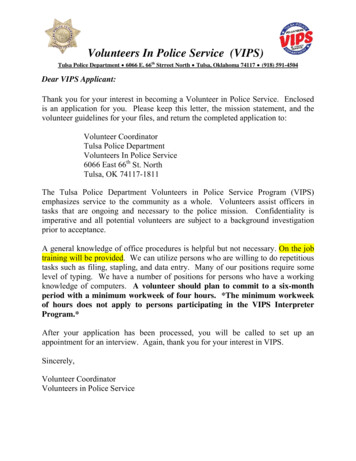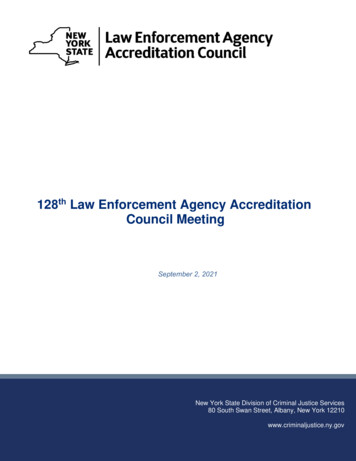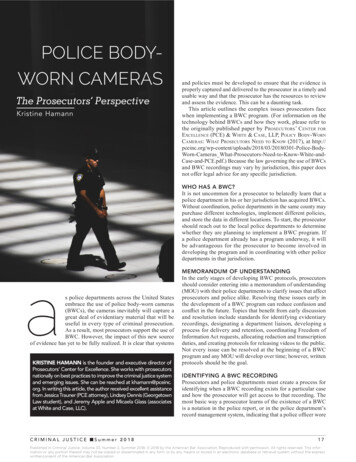
Transcription
POLICE BODYWORN CAMERASThe Prosecutors’ PerspectiveKristine Hamannand policies must be developed to ensure that the evidence isproperly captured and delivered to the prosecutor in a timely andusable way and that the prosecutor has the resources to reviewand assess the evidence. This can be a daunting task.This article outlines the complex issues prosecutors facewhen implementing a BWC program. (For information on thetechnology behind BWCs and how they work, please refer tothe originally published paper by Prosecutors’ Center forExcellence (PCE) & White & Case, LLP, Policy Body-WornCameras: What Prosecutors Need to Know (2017), at 301-Police-BodyWorn-Cameras E.pdf.) Because the law governing the use of BWCsand BWC recordings may vary by jurisdiction, this paper doesnot offer legal advice for any specific jurisdiction.WHO HAS A BWC?It is not uncommon for a prosecutor to belatedly learn that apolice department in his or her jurisdiction has acquired BWCs.Without coordination, police departments in the same county maypurchase different technologies, implement different policies,and store the data in different locations. To start, the prosecutorshould reach out to the local police departments to determinewhether they are planning to implement a BWC program. Ifa police department already has a program underway, it willbe advantageous for the prosecutor to become involved indeveloping the program and in coordinating with other policedepartments in that jurisdiction.as police departments across the United Statesembrace the use of police body-worn cameras(BWCs), the cameras inevitably will capture agreat deal of evidentiary material that will beuseful in every type of criminal prosecution.As a result, most prosecutors support the use ofBWC. However, the impact of this new sourceof evidence has yet to be fully realized. It is clear that systemsKRISTINE HAMANN is the founder and executive director ofProsecutors’ Center for Excellence. She works with prosecutorsnationally on best practices to improve the criminal justice systemand emerging issues. She can be reached at khamann@pceinc.org. In writing this article, the author received excellent assistancefrom Jessica Trauner (PCE attorney), Lindsey Dennis (GeorgetownLaw student), and Jeremy Apple and Micaela Glass (associatesat White and Case, LLC).CRIMINAL JUSTICE nSummer 2018MEMORANDUM OF UNDERSTANDINGIn the early stages of developing BWC protocols, prosecutorsshould consider entering into a memorandum of understanding(MOU) with their police departments to clarify issues that affectprosecutors and police alike. Resolving these issues early inthe development of a BWC program can reduce confusion andconflict in the future. Topics that benefit from early discussionand resolution include standards for identifying evidentiaryrecordings, designating a department liaison, developing aprocess for delivery and retention, coordinating Freedom ofInformation Act requests, allocating redaction and transcriptionduties, and creating protocols for releasing videos to the public.Not every issue can be resolved at the beginning of a BWCprogram and any MOU will develop over time; however, writtenprotocols should be the goal.IDENTIFYING A BWC RECORDINGProsecutors and police departments must create a process foridentifying when a BWC recording exists for a particular caseand how the prosecutor will get access to that recording. Themost basic way a prosecutor learns of the existence of a BWCis a notation in the police report, or in the police department’srecord management system, indicating that a police officer wore17Published in Criminal Justice, Volume 33, Number 2, Summer 2018. 2018 by the American Bar Association. Reproduced with permission. All rights reserved. This information or any portion thereof may not be copied or disseminated in any form or by any means or stored in an electronic database or retrieval system without the expresswrittenconsent of the American Bar Association.
a BWC. The prosecutor also may be provided with a list ofofficers who wear BWCs that can be compared to new arrests.With more sophisticated systems, the prosecutor will know thereis a BWC recording when a link to the recording is receivedthrough proprietary software. Regardless of the system used,when interviewing an officer, the prosecutor always should askthe police officer whether a BWC was worn by the officer or byany other officer at the scene.Another essential source of information is the policedepartment’s BWC liaison. The appointment of a liaison is acritical component in facilitating the proper flow of informationfrom the police to the prosecutor. The liaison can perform avariety of tasks that range from reviewing, categorizing, andauditing videos, to ensuring that the videos are properly identifiedand sent to the prosecutor.TAGGING BWC RECORDINGSBecause law enforcement agencies and prosecutors’ offices’ donot have the resources to review all BWC recordings, policeofficers and prosecutors must have the ability to quickly identifythe relevant portions of a BWC recording. A BWC upload maycontain hours of irrelevant footage captured throughout anofficer’s shift. To identify the evidentiary portions of a recording,most BWC systems allow officers to “tag” the recording andprovide additional information such as crime type. The tags alsowill determine how the recording is stored and retained; forexample, a recording that is tagged as a felony will be retainedlonger than a recording tagged as a misdemeanour. In additionto tags, a BWC recording also may have imbedded metadata thatprovide additional information such as date, time, BWC number,and sometimes geocoding. Prosecutors should provide input onwhat is considered to be of evidentiary value.Especially in the initial stages of a BWC program, there maybe instances when there is no tagging on the BWC recordingor the officer has incorrectly tagged a recording. This creates asignificant burden on the prosecutor, who must attempt to connecta recording with an event. The prosecutor should establish aprotocol for dealing with this issue. Some departments haveshort retention periods for BWC footage that is not consideredevidence, so a recording that is not tagged as evidentiary may bedestroyed before the prosecutor realizes that it existed.PROVIDING THE RECORDING TO THEPROSECUTOROnce the prosecutor has determined that there is a BWCrecording associated with a case, there are a variety of waysthat the prosecutor receives the recording. Often in smallerjurisdictions where the BWC recordings are stored on a localserver, a prosecutor simply may be provided a DVD withthe BWC video footage. In some instances, recordings fromthe officer’s entire shift will be on the DVD, requiring theprosecutor to find the relevant recording. In other instances,the police department will copy only the relevant sections ontothe DVD. Some police departments also may create DVDs fordefense counsel.In larger jurisdictions where there is a high volume of BWCrecordings, most police departments have chosen to store their18recordings with private vendors in the cloud. Thus, rather thanreceiving a DVD, the assigned prosecutor is given a link to aproprietary system and granted access to the location within thecloud where the recording resides. In prosecutor offices withtheir own BWC liaison, the link is sent to a central locationand the liaison will forward the link to the prosecutor who ishandling the case.TECHNOLOGICAL CAPACITY WITHIN THEPROSECUTOR’S OFFICEA prosecutor must assess the office’s capability to adequatelyhandle a BWC program. Before the BWC program begins, theprosecutor should determine if the office is capable of receivingthe recordings in the format provided by the police. For example,some prosecutors have received DVDs from the police withouthaving a compatible DVD player. (See Dist. Att’ys Ass’n ofState of N.Y., Testimony Before Assembly: Police Body-WornCameras Show Great Promise, but Issues Must Be ResolvedBefore Program Goes State-wide (Dec. 8, 2015), 12.8.2015.pdf.)In addition, the prosecutor’s own computer system and networkmust be robust enough to handle the large amount of additionaldata generated by BWCs. BWCs create large files that caneasily fill up a prosecutor’s hard drive and negatively impactthe office’s network as files are being downloaded from thecloud. (Joel Nihlean, Looking Through the Lens of Body-WornCameras: A Full Picture Approach, 28 Cnty. (Tex. Ass’n ofCtys.), no. 1, Jan./Feb. 2016, at 22. /CountyMag JanFeb2016.pdf.) Where an office’s Internet bandwidth is insufficient, itcan take hours to download BWC files, consuming the office’sbandwidth and slowing down the office’s entire network. (CBPBody-Worn Camera Working Grp., U.S. Customs & BorderPatrol, Body-Worn Camera Feasibility Study Report 12 (Aug.2015), bodyworn-camera-20151112.pdf.) Even with adequate bandwidth,downloading hours of video will take time and expend resources.If a private vendor owns the cloud storage system usedby the police, the prosecutor may need a software licenseto use the system. This will typically involve a fee, such asa one-time purchase or a subscription. (One vendor providesprosecutors free access to the cloud; however, it is possible thatfees will be charged in the future. (See, e.g., Evidence.com forProsecutors, Axon, https://www.axon.com/products/evidenceprosecutor (last visited Feb. 27, 2018).) If police departmentswithin a prosecutor’s jurisdiction use different private vendors,the prosecutor may need to purchase separate licenses foreach type of BWC program. Where licenses are required, theprosecutor’s office must decide whether to purchase a licensefor each prosecutor or to purchase licenses that can be shared.Redaction of BWCs also requires robust computer power thatmay not be available in some prosecutor offices. If redaction isdone on the cloud, there may be additional charges for proprietaryredaction tools. The number of licenses needed will depend onwhether the redaction is done in a centralized location or by theassigned prosecutor.CRIMINAL JUSTICE nSummer 2018Published in Criminal Justice, Volume 33, Number 2, Summer 2018. 2018 by the American Bar Association. Reproduced with permission. All rights reserved. This information or any portion thereof may not be copied or disseminated in any form or by any means or stored in an electronic database or retrieval system without the expresswrittenconsent of the American Bar Association.
Prosecutor storage of BWC recordings is another challenge.The BWC footage received from the police can be stored on aDVD, remain in the police department’s cloud, be saved on theassigned prosecutor’s computer, or downloaded to an electroniccase file on the prosecutor’s office server. Each method presentsits own technical issues and expenses. Importantly, in additionto the file originally received from the police department, theprosecutor must save any portions of the BWC recordings thatare introduced at trial, redacted or enhanced in any way. Ideally,the BWC recordings should be stored with the related case fileand with all other digital evidence associated with the file, suchas crime scene photos and surveillance videos. Separately storingBWC evidence and other digital evidence from the rest of thecase file will make it more difficult to find years later, if needed.A BWC program may be the impetus to upgrade aprosecutor’s technological capacity because it cannot functionefficiently without a robust network, ample server space, andup-to-date computers.REDACTIONSProsecutors will need to redact BWC recordings for a numberof reasons, including witness protection, court orders, freedomof information requests, and creation of excerpts for trial.If an individual’s identity or image is to be protected fromdissemination, then redaction of the face or other identifyingfeatures is required for each frame, by “black out” or “pixilation.”(Steven M. Clem, Wash. Ass’n of Prosecuting Att’ys Comm., Useof Body-Worn Cameras by Law Enforcement: Considerations,Issues and Concerns 11 (June 2, 2015), ngton-Link-1.pdf.) Additionalredaction methods include making the entire recording fuzzy,snipping out sections, or automated redaction that can assistwith recognizing, following, and redacting a face or object.Many types of redaction systems are available; however, theymay require a license and staff must be trained in their use.Prior to purchase, the prosecutor’s office must make sure thatthe software is compatible with its existing systems, networkstrength, and storage capacity and that the program keeps trackof all changes made to the original file.Redaction is extremely time-consuming. The averageBWC video is 13 minutes long and it takes a trained personapproximately one hour to review and redact information froma recording of that length. (James R. Benjamin et al., MayorRawlings-Blake’s Working Group on the Use and Implementationof Body-Worn Cameras: Draft Recommendations 24, Balt.City Mayor’s Office (2015), /20150218BWCWorkingGroupRecommendations.pdf; QueTel, Body-Worn Camera Video Redaction—MoreThan It Seems, PoliceOne.com (Oct. 4, 2016), ra-video-redaction-morethan-it-seems/.) Once the recording is redacted, additional time isnecessary to render or “finalize” the file, which can take anywherefrom the real-time duration of the recording to up to one andone-half times the length of the clip. Depending on the redactionsystem, the computer used may be otherwise unavailable duringthe rendering process, thus requiring a dedicated computer.(See G lobal J ustice I nfo . S haring I nitiative , B ureau ofCRIMINAL JUSTICE nSummer 2018Justice Assistance, U.S. Dep’t of Justice, Video Evidence: APrimer for Prosecutors (Oct. 2016); Michael D. White, OJPDiagnostic Ctr., Dep’t of Justice, Police Officer Body-WornCameras: Assessing the Evidence 34 (2014), files/spotlight/download/Police Officer Body-Worn Cameras.pdf.)The redaction process is expensive in terms of the staff,resources, time, and technology required, and there may bemuch debate between police and prosecutors regarding whois responsible for this task. One study projected that redactioncosts would consume as much as 21 percent of its BWC budget.It is estimated that, even if the process were to be outsourced toa third party (which still will require a frame-by-frame reviewby the prosecutor), video redaction still would cost an estimated 50 per hour. (Benjamin et al., Mayor Rawlings-Blake’s WorkingGroup, supra, at 10.)Enhanced technologies, such as facial recognition software,may simplify the redaction process in the future; however,there will always be a need for double checking each frameof a recording to make sure that the redaction was completeand properly made. (Karen Weise; Could Face RecognitionBe on Police Body-Worn Cameras by 2017?, P lanetBioMetrics (July 20, 2016), worn-cameras-by-2017.)STAFFING NEEDS FOR PROSECUTOR’S OFFICE TOMANAGE BWC DATAProperly implementing and overseeing a BWC camera policywill require additional staff for a prosecutor’s office. Thesesignificant personnel costs are usually not included in the initialplanning for a BWC program. When a police department beginsits BWC program, it is important for funding authorities to knowthe substantial staffing implications for prosecutors.Ideally, a prosecutor’s office should have a legal liaisonand an administrative liaison to manage the BWC recordings.The legal liaison can develop polices and protocols, addressdiscovery issues, coordinate with the courts and defense, andoversee freedom of information requests. One important policythat requires legal input is the retention time for the recordings.This demands coordination between the police and the prosecutorto ensure that relevant recordings are maintained throughout thecase and possibly also the appeal. Finally, the legal liaison cancollect BWC recordings that are useful for training by the policeor prosecutors and any recordings that demonstrate a need fordisciplinary action.The prosecutor’s administrative BWC liaison can beresponsible for an array of technical and logistical issues.These include receiving the recordings, tracking outstandingrequests, sending recordings to the assigned or reassignedprosecutor, associating untagged recordings with cases, storingBWC recordings, addressing redaction issues, and coordinatingtranscription of BWCs. The administrator also will have to keeptrack of available licenses and passwords. (Damon Mosler,Considerations for Policies on Body Worn Cameras in ProsecutorOffices (May 2016) (unpublished paper on file with author).) Ina large office, many prosecutors may have passwords for BWCreviewing systems; keeping track of the passwords as prosecutors19Published in Criminal Justice, Volume 33, Number 2, Summer 2018. 2018 by the American Bar Association. Reproduced with permission. All rights reserved. This information or any portion thereof may not be copied or disseminated in any form or by any means or stored in an electronic database or retrieval system without the expresswrittenconsent of the American Bar Association.
leave the office or change positions within the office can bedifficult. The administrative liaison also may have to burn DVDsof BWC recordings for defense counsel or to introduce in court.BWCs place a significant drain on the time of the assignedprosecutor. Viewing a BWC recording is far more timeconsuming than reading a police report that summarizes anevent. If there are multiple officers at a scene, viewing timewill be increased further as the recordings of each officer mayhave to be viewed. For example, a one-hour event could resultin five hours of viewing if five officers with BWCs were at thescene. In contrast, before BWCs, this same event may havebeen summarized in a one-page police report that could be readin five minutes. One prosecutor explained the impact of BWCson a prosecutor’s office by saying it is as if every police reportincreased from four pages to 60 pages. (Telephone Interview withJohn Haroldson, Dist. Att’y, Benton Cnty., OR (Apr. 14, 2017).)To assist with viewing BWC recordings, some vendors havedeveloped an accelerated fast-forward function that allowsthe video to be viewed quickly. Some BWC systems utilizetechnology that allows for simultaneous review of multiplerecordings in a split screen. (See Evidence.com for Prosecutors,supra.) The disadvantage of these methods is that it is easy tomiss something that may be significant, particularly becauseany sound on the recording will not be heard when viewing inan accelerated or multiple-recording mode.A prosecutor’s office should implement policies for when, andif, the BWC footage must be viewed. This policy will directlyimpact the number of additional prosecutor work hours thatare needed as a result of a BWC program. In offices whereprosecutors are not required to view every recording prior todiscovery or plea, the staffing needs may be less. However,regardless of policy, there is no doubt that BWCs inevitably willincrease the amount of time it takes a prosecutor to thoroughlyinvestigate a case.In addition to needing staff to redact recordings as discussedpreviously, staff also may be needed to transcribe BWCrecordings that are introduced in court. Some states, such asCalifornia and Minnesota, require a transcript to accompany anyrecording introduced as evidence. (See Cal. R. Ct. 2.1040(b)(2016) (stating transcript of video recording must be providedbefore recording may be entered into evidence); Minn. R.Crim. Proc. 26.03(16) (stating that provision of transcript isoptional prior to introducing video recording into evidence).)Transcribing a recording is time-consuming and requires staff.Some BWC system vendors offer related online transcriptionservices that may reduce the time and personnel needed foraudio-video transcription. (See, e.g., SpeakWrite for AxonEvidence.com Platform, Axon, http://speakwrite.com/axon.)However, outsourced transcripts always must be checked byprosecutor staff to verify their accuracy. If the recording is ina foreign language, a translator will be needed in addition totranscription services.Qualified IT staffing is a critical component of a BWCprogram. Given the many technological challenges of a BWCsystem, it is essential to have competent and reliable IT support.Some prosecutor offices depend on centralized, countywide ITsupport. An office’s ability to adjust to a BWC program canbe significantly impacted if the county’s IT support has other20priorities and cannot attend to the prosecutor’s office.Training also is needed for prosecutors and support staffto teach them how to deal with BWC issues, including officepolicies, access to the recordings, redaction, discovery,transcription, and introduction of the evidence.In sum, the amount of digital evidence used in criminal casesis exploding and is significantly increasing the staffing needs ofa prosecutor’s office. Prosecutors and their staff must be trainedand ready for a variety of challenges related to this evidence,including collection, viewing, redaction, storage, editing, discovery,and introduction of the evidence in court. (See Global Justice Info.Sharing Initiative, Video Evidence, supra (providing guidance onusing video evidence in the courtroom).)VIEWING BWC RECORDINGS AND DISCOVERYOnce a prosecutor has received a BWC recording, it will be subjectto the same rules of discovery as other information received fromthe police. Ideally, a prosecutor should view all recordings in theearly stages of a case and prior to turning it over to the defense.The recording may reveal useful evidence to support a prosecutionor uncover information that exonerates a defendant. It also mayexpose issues that require additional investigation and assessment.As with any evidence, prosecutors must be mindful not to releaseinformation that could put a witness’s safety at risk. Similarly,issues regarding privacy or confidential police tactics may preventthe release of some information contained in a BWC recording.Though early viewing of BWC recordings is a laudable goal, costand staffing considerations may make this extremely difficult, ifnot impossible.If it is not possible to review every BWC recording beforediscovery, prosecutors may need to focus on certain types of caseswhere the police report or the BWC tags suggest a higher likelihoodthat the recording contains sensitive information. For example,prosecutors may wish to review recordings of specific types ofevents, such as violent felonies, victim-related crimes, recordings ofminors, and other situations where concerns of witness intimidationor privacy may be present. Assigning paralegals or interns to conductan initial screening review of BWC recordings is one potentialway to balance capacity constraints with necessary pre-discoveryviewing. Prosecutors should be mindful that even if a recordingis not viewed, the prosecutor has constructive knowledge of itscontents. Ultimately, individual offices’ discovery procedures andlocal statutes will govern when the recordings must be turned over.Viewing and identifying discoverable material is not the endof the challenge. The prosecutor will have to determine how toprovide defense counsel with access to the recordings. This canbe done by providing the defense with a DVD, sending a link tothe recording stored in a cloud system, or allowing viewing in theprosecutor’s office. However, some defense counsel do not havethe computer capacity or the technical knowledge needed to viewthe recordings. Accommodations will have to be made to completediscovery. Regardless of how the BWC recording is provided to thedefense, a good record must be kept of when the information wassent to and received by the defense.RELEASE OF BWC RECORDINGSEthical rules such as Ethical Rule 3.8 (Special Responsibilities ofa Prosecutor) of the ABA Model Rules of Professional ConductCRIMINAL JUSTICE nSummer 2018Published in Criminal Justice, Volume 33, Number 2, Summer 2018. 2018 by the American Bar Association. Reproduced with permission. All rights reserved. This information or any portion thereof may not be copied or disseminated in any form or by any means or stored in an electronic database or retrieval system without the expresswrittenconsent of the American Bar Association.
may prohibit prosecutors from releasing recordings to the publicwhile a criminal case is pending. The rule states: “except forstatements that are necessary to inform the public of the natureand extent of the prosecutor’s action and that serve a legitimatelaw enforcement purpose, refrain from making extrajudicialcomments that have a substantial likelihood of heightening publiccondemnation of the accused and exercise reasonable care to preventinvestigators, law enforcement personnel, employees or otherpersons assisting or associated with the prosecutor in a criminalcase from making an extrajudicial statement that the prosecutorwould be prohibited from making under Rule 3.6 or this Rule.”(Model Rules of Prof’l Conduct r. 3.8 (Am. Bar Ass’n al responsibility/publications/model rules of professional conduct/rule 3 8special responsibilities of a prosecutor.html; see also ProsecutingAtt’ys Ass’n of Mich., Best Practices Recommendation: Prosecutorand Law Enforcement Communication to Media (June 19, M Best PracticesCommunications to Media.pdf.) In addition to professional conductrules for prosecutors, local rules also may prohibit disclosure. Forexample, in Indiana, prosecutors who prematurely release evidenceduring a criminal proceeding may be subject to disciplinary actionbefore the Indiana Supreme Court Disciplinary Commission. (SeeMarilyn Odendahl, Prosecutors Say Ethics Rules Limit Releaseof Police Body Camera Video,” Ind. Law., June 29, 2016, o/PARAMS/article/40732(citing Ind. R. Prof. Conduct §§ 3.6, 3.8).)One area of debate between police and prosecutors is when andif to release BWC footage, particularly during the investigativephase of a case. The police, who own the BWC recordings, aremore likely to release a recording as soon as possible if neededto quell concerns in the community. In contrast, prosecutorsmay argue against early release of the recording for fear that itmight interfere with the investigation and influence witnesses.It is useful for the police and the prosecutor to discuss this issueas a BWC program is being developed and before a high-profileincident occurs.trail that can track who has viewed or altered the recording.For prosecutors to present BWC recordings in the grand juryor in court, there must be the necessary equipment to play therecordings. Most jurisdictions provide that “the party offeringthe video evidence is responsible for appearing at the hearingor trial with [the evidence] and arranging for it to be played.”(Id.) Modern courtrooms may have the appropriate equipmentavailable to play recordings, such as a widescreen television, aprojector, computer, wireless Internet, and other equipment. Inother, less sophisticated court rooms, however, the parties mayhave to “carry the required equipment into the courtroom toshow the video.” (Id.)Typically, even when a BWC recording is stored in a cloudsystem, the BWC recording will be introduced into evidenceusing a CD/DVD. The current rules of evidence “do not allowparties to move a data stream into evidence.” (Id.) In the future,parties may be able to upload BWC videos directly to a court’scase management system, from which the video can be playedto the jury and, once admitted into evidence, also “included inthe electronic case file . . . like an electronic document.” (Id. at6.) It even may be possible to “stream a BWC video directlyfrom its cloud-based environment to show to the judge or jury.”(Id. at 5.) Notably, however, this technology is currently out ofreach for most jurisdictions.” (Id.)INTRODUCING BWC RECORDINGS AS EVIDENCEAs with other evidence, before the BWC video can be admittedinto evidence and published to the jury, it must be authenticated.(Greg Hurley, Nat’l Ctr. for State Courts, Body-Worn Camerasand the Courts (2016), http://www.ncsc-jurystudies.org/ /media/files/pdf/jury/final%20bwc%20report.ashx.) Typically, a BWCvideo is authenticated by a witness to the event, usually the officerwearing the BWC, who will testify that the BWC recordingfairly and accurately represents what the witness observed. If theofficer wearing the BWC is not available, someone else who wasat the scene may be able to testify that the recording is a true andaccurate representation of what occurred at that date and time.If the authenticity of a BWC video is challenged, or a partyalleges that the recording has been altered, prosecutors shouldbe prepared to establish the BWC video’s chain of custody fromthe start of the recording to its presentation in the courtroom.(Id. at 5.) To establish the chain of custody, the prosecutorsshould consider when and how the BWC video was uploaded,who had access to the video, and the availability of an auditCONCLUSIONFrom daily news broadcasts to the courtroom, police BWCs area topic of conversation and debate. BWCs are now expected bythe pub
identifying when a BWC recording exists for a particular case and how the prosecutor will get access to that recording. The most basic way a prosecutor learns of the existence of a BWC is a notation in the police report, or in the police department's record management system, indicating that a police officer wore a

